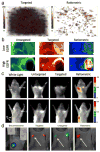Quantitative in vivo cell-surface receptor imaging in oncology: kinetic modeling and paired-agent principles from nuclear medicine and optical imaging
- PMID: 26134619
- PMCID: PMC4522156
- DOI: 10.1088/0031-9155/60/14/R239
Quantitative in vivo cell-surface receptor imaging in oncology: kinetic modeling and paired-agent principles from nuclear medicine and optical imaging
Abstract
The development of methods to accurately quantify cell-surface receptors in living tissues would have a seminal impact in oncology. For example, accurate measures of receptor density in vivo could enhance early detection or surgical resection of tumors via protein-based contrast, allowing removal of cancer with high phenotype specificity. Alternatively, accurate receptor expression estimation could be used as a biomarker to guide patient-specific clinical oncology targeting of the same molecular pathway. Unfortunately, conventional molecular contrast-based imaging approaches are not well adapted to accurately estimating the nanomolar-level cell-surface receptor concentrations in tumors, as most images are dominated by nonspecific sources of contrast such as high vascular permeability and lymphatic inhibition. This article reviews approaches for overcoming these limitations based upon tracer kinetic modeling and the use of emerging protocols to estimate binding potential and the related receptor concentration. Methods such as using single time point imaging or a reference-tissue approach tend to have low accuracy in tumors, whereas paired-agent methods or advanced kinetic analyses are more promising to eliminate the dominance of interstitial space in the signals. Nuclear medicine and optical molecular imaging are the primary modalities used, as they have the nanomolar level sensitivity needed to quantify cell-surface receptor concentrations present in tissue, although each likely has a different clinical niche.
Figures






References
-
- Molecular Imaging: Principles and Practice. Shelton, CT: People’s Medical Publishing House (PMPH) - USA; 2010.
-
- Allen TM, Cullis PR. Drug delivery systems: entering the mainstream. Science. 2004;303:1818–22. - PubMed
-
- Annis DA, Shipps GW, Jr, Deng Y, Popovici-Muller J, Siddiqui MA, Curran PJ, Gowen M, Windsor WT. Method for quantitative protein-ligand affinity measurements in compound mixtures. Analytical chemistry. 2007;79:4538–42. - PubMed
-
- Ardeshirpour Y, Hassan M, Zielinski R, Horton JA, Capala J, Gandjbakhche AH, Chernomordik V. In Vivo Assessment of HER2 Receptor Density in HER2-positive Tumors by Near-infrared Imaging, Using Repeated Injections of the Fluorescent Probe. Technology in cancer research & treatment. 2014;13:427–34. - PMC - PubMed
Publication types
MeSH terms
Substances
Grants and funding
LinkOut - more resources
Full Text Sources
